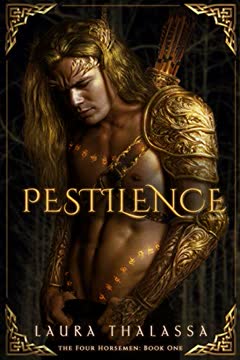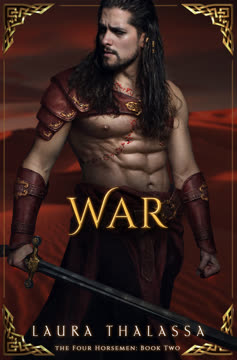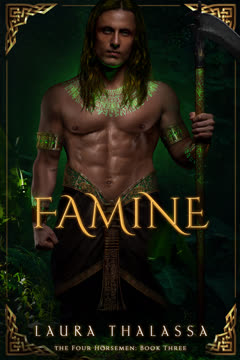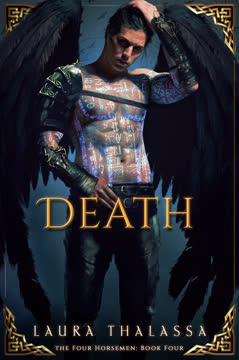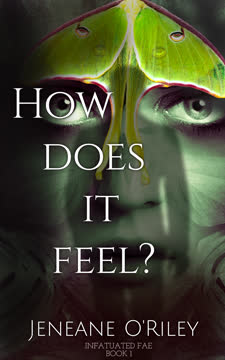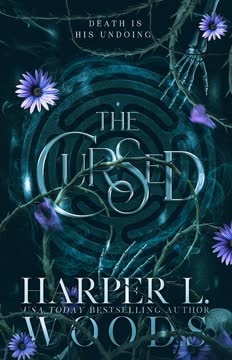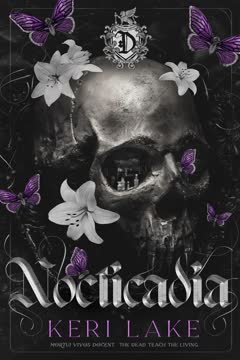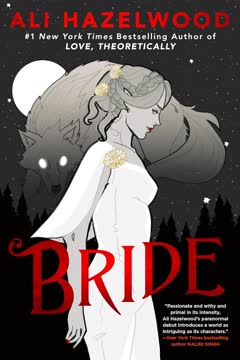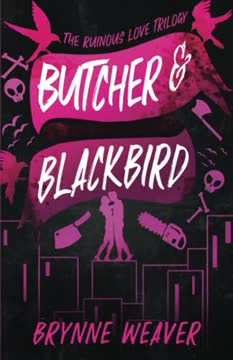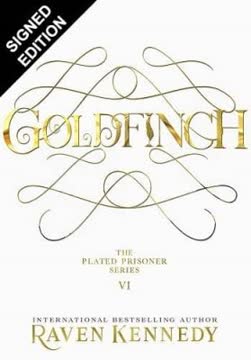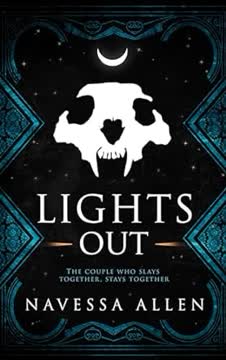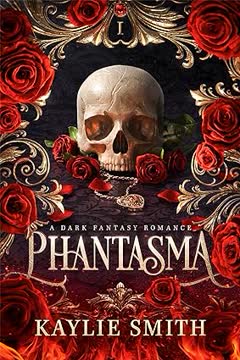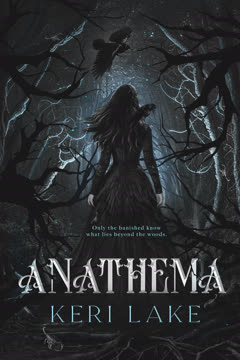Plot Summary
Apocalypse Unleashed
The Four Horsemen of the Apocalypse arrive, shattering civilization. Technology fails, society collapses, and humanity is thrust into darkness. Pestilence, the first horseman, rides out to spread a deadly plague, leaving cities empty and hope in short supply. Sara Burns, a firefighter in Whistler, Canada, faces the end of the world with grim determination, clinging to her family and her sense of duty. The world is no longer ruled by reason or science, but by fear, faith, and the inescapable presence of death. The Age of Man is over; the Age of the Horseman has begun.
Drawing the Black Match
In the aftermath of the Horsemen's arrival, Sara and her fellow firefighters draw lots to decide who will stay behind and attempt to kill Pestilence. Sara draws the black match, sealing her fate. She prepares for a suicide mission, knowing she will likely die but hoping to save her family and the world. Her resolve is steely, but beneath it lies fear and sorrow for the life she's leaving behind. As she waits for Pestilence, Sara's humanity and courage are tested, setting her on a path that will change her forever.
The Failed Assassination
Sara ambushes Pestilence, shooting him and setting him on fire in a desperate attempt to end his reign. But Pestilence is unkillable; he survives, regenerates, and takes Sara captive as punishment for her attack. The horror of her actions haunts her, and the reality of Pestilence's immortality crushes any hope of a quick victory. Sara's world narrows to pain, regret, and the terrifying presence of the Horseman, who promises to make her suffer for her defiance.
Captive of Pestilence
Bound and forced to run behind Pestilence's horse, Sara endures physical torment and humiliation. Pestilence is both cruel and strangely attentive, tending to her wounds even as he inflicts new ones. Their journey is a brutal march through abandoned towns and dying cities, with Sara witnessing the devastation of the plague firsthand. The line between captor and captive blurs as Pestilence's actions reveal glimpses of something almost human beneath his divine wrath.
Suffering and Survival
As Sara is dragged from place to place, she is forced to confront the limits of her endurance and the depths of Pestilence's power. She witnesses the agony of plague victims, cares for the dying, and is herself brought to the brink of death. Pestilence's refusal to let her die becomes both a curse and a strange mercy. Through shared suffering, a fragile connection forms, marked by moments of unexpected tenderness and mutual recognition of pain.
The Unkillable Horseman
Pestilence reveals the futility of resistance—he has been attacked countless times, but cannot be destroyed. His immortality is both his weapon and his prison, separating him from the mortals he judges. Sara's attempts to escape are met with swift, brutal consequences, but Pestilence's punishments are laced with a growing reluctance. The Horseman's loneliness and alienation become apparent, hinting at a vulnerability beneath his divine mission.
The Road of Death
Sara and Pestilence travel across plague-ravaged lands, encountering the best and worst of humanity. Sara's compassion compels her to help the sick and dying, even as Pestilence insists on the inevitability of death. Their conversations grow deeper, exploring faith, morality, and the meaning of suffering. Sara's resilience and empathy begin to affect Pestilence, challenging his certainty and sowing seeds of doubt about his purpose.
Mercy and Monstrosity
Sara's acts of kindness, even in the face of horror, force Pestilence to confront the complexity of humanity. He is both judge and executioner, but Sara's presence awakens something new in him—a capacity for mercy. The two share moments of vulnerability, and Pestilence's punishments become less severe. Sara, in turn, is forced to reckon with her own capacity for violence and the seductive pull of power and vengeance.
The Plague's Toll
Sara cares for families as they succumb to the plague, bearing witness to their final moments. The suffering she endures is no longer just physical, but deeply emotional. Pestilence is affected by her grief, and his divine detachment begins to crack. The deaths of innocents weigh on both of them, and Sara's pleas for mercy challenge Pestilence's resolve. The cost of the apocalypse is measured not just in bodies, but in the erosion of hope and the transformation of the soul.
Kindness in Catastrophe
Amidst devastation, Sara and Pestilence find moments of connection—shared meals, poetry, and even laughter. Pestilence's curiosity about humanity deepens, and Sara's courage and compassion draw him closer. Their relationship shifts from adversarial to intimate, culminating in acts of physical and emotional vulnerability. Love and desire bloom in the ruins, offering a fragile hope that even the harbinger of death can be changed by the touch of another.
Escape and Recapture
Sara attempts to escape, but is recaptured and punished. The cycle of suffering and forgiveness intensifies, each escape attempt deepening their bond. Pestilence's feelings for Sara become undeniable, and he struggles with the conflict between his divine mission and his growing love. Sara, too, is torn between her loyalty to humanity and her attachment to the Horseman. Their fates become inextricably linked, each shaping the other's destiny.
The Slow Transformation
As Sara heals from her wounds, Pestilence's care becomes more tender, and his hatred for humanity softens. He begins to question the righteousness of his mission, and his love for Sara becomes a force that challenges his very nature. Sara, in turn, is changed by her experiences—her understanding of mercy, suffering, and forgiveness deepens. Together, they navigate the complexities of love in a world that seems beyond saving.
Love Among Ruins
Sara and Pestilence's relationship deepens into true love, marked by vulnerability, passion, and mutual respect. They share their fears, hopes, and histories, finding solace in each other's arms. Pestilence reveals his divine origins and the burden of his immortality, while Sara offers him the gift of her humanity. Their love becomes a sanctuary in the midst of chaos, but it is also a crucible that will test their convictions and force them to make impossible choices.
The Price of Vengeance
When Sara is gravely wounded by those seeking vengeance, Pestilence's grief and rage drive him to unleash the full force of his plague, devastating entire regions. His love for Sara, once a source of mercy, becomes a weapon of wrath. Sara, caught between life and death, confronts the consequences of their bond and the terrible cost of vengeance. The world teeters on the brink of annihilation, and the line between savior and destroyer blurs.
The Breaking Point
Sara recovers, but the world is in ruins. Pestilence, consumed by guilt and love, surrenders his mission and releases Sara from captivity. Their relationship fractures under the weight of loss and betrayal. Sara leaves, seeking solace among the survivors, while Pestilence disappears, his purpose spent. Both are haunted by what they have done and what they have become, their love seemingly destroyed by the very apocalypse it was meant to survive.
The World's End
Sara returns home, struggling to find meaning in a world forever changed. The plague has ended, but the scars remain—on the land, on the people, and on her heart. She is celebrated as a hero, but feels only emptiness and longing. The memory of Pestilence lingers, a reminder of love lost and the price of survival. The world rebuilds, but the threat of the remaining Horsemen looms, and the lessons of mercy and redemption are fragile and easily forgotten.
The Choice of Mercy
News spreads that the plague has miraculously vanished, and the sick have recovered. Sara learns that Pestilence, moved by love and mercy, reversed the devastation he caused. He sacrificed his purpose and immortality for the sake of humanity and for her. The realization that love can change even the most unyielding heart brings hope, but also regret for the pain and loss endured. Sara's faith in redemption is restored, and the possibility of forgiveness emerges.
Redemption and Return
Pestilence returns to Sara, stripped of his divine trappings and seeking a new life as a man. He asks for her forgiveness and her love, offering a future built on hope rather than destruction. Together, they choose each other, forging a new path in a world forever altered. Their love, born in suffering and tested by apocalypse, becomes a testament to the power of mercy, compassion, and the enduring human spirit. As the threat of the next Horseman rises, Sara and Pestilence—now Victor—face the future together, united by love and the hard-won lessons of the end of the world.
Characters
Sara Burns
Sara is a firefighter whose sense of duty and self-sacrifice sets the story in motion. Chosen by fate to confront Pestilence, she is both courageous and deeply human—haunted by guilt, driven by love, and marked by suffering. Her journey from would-be assassin to captive, caregiver, and ultimately lover of Pestilence is a study in resilience and transformation. Sara's compassion is her greatest strength, allowing her to see the humanity in even the most monstrous, and her willingness to forgive and love becomes the catalyst for redemption. Her psychological arc is one of growth through pain, as she learns the limits of vengeance and the power of mercy.
Pestilence (Victor)
Pestilence is the first Horseman of the Apocalypse, an immortal being tasked with ending humanity through plague. He is at once divine and deeply isolated, his immortality a source of both power and loneliness. Initially cold, cruel, and unyielding, Pestilence is gradually changed by his relationship with Sara. Her compassion and resilience awaken in him a capacity for mercy, doubt, and ultimately love. His struggle between duty and desire, vengeance and forgiveness, forms the emotional core of the story. Pestilence's transformation from destroyer to redeemer is both tragic and hopeful, illustrating the possibility of change even in the most unyielding.
Ruth and Rob
An elderly couple who welcome Sara and Pestilence into their home, Ruth and Rob embody the best of humanity—kindness, acceptance, and unwavering love. Their willingness to forgive Pestilence and comfort him in their final moments leaves a profound impact on both protagonists. They serve as a model of what is worth saving in the world, and their deaths are a turning point for both Sara and Pestilence, deepening their understanding of love, loss, and mercy.
Nick Jameson
Nick is a man whose fear and hatred drive him to violence against Sara and Pestilence. His actions—rooted in grief and a desperate need for control—highlight the capacity for cruelty and vengeance in the face of apocalypse. Nick's interactions with Sara and Pestilence force both to confront the darker aspects of humanity and themselves, serving as a foil to the story's themes of compassion and forgiveness.
Luke, Felix, Briggs
Fellow firefighters who share Sara's sense of duty and willingness to risk everything for others. Their decision to draw lots and stay behind to face Pestilence underscores the story's exploration of sacrifice, fate, and the randomness of survival. Their fates haunt Sara, reminding her of the cost of heroism and the weight of survivor's guilt.
Thanatos (Death)
The fourth Horseman, Thanatos appears in Sara's near-death experience as a shadowy, winged figure. He represents the inevitability of death and the limits of human agency. His brief interaction with Sara serves as a reminder of the larger forces at play and foreshadows the coming of the next apocalypse.
Ezekiel (The Prophet)
Ezekiel is a self-proclaimed prophet who offers Pestilence women in exchange for mercy. His actions expose the dangers of fanaticism, the commodification of women, and the ways in which faith can be twisted to justify self-interest. He serves as a critique of blind devotion and the moral compromises made in the face of extinction.
Mac and the Gang
The group that tortures Pestilence and wounds Sara represents the capacity for violence and dehumanization in desperate times. Their actions push Pestilence to the brink, unleashing his wrath and forcing a reckoning with the consequences of unchecked vengeance.
Trixie Skillz
Pestilence's immortal horse, Trixie, is both companion and symbol. The horse's endurance and suffering mirror Pestilence's own, and his presence provides moments of levity and comfort. Trixie's survival and loyalty underscore the story's themes of faithfulness and the bonds that endure even in apocalypse.
Sara's Parents
Though largely absent, Sara's parents represent the life and love she fights to protect. Their survival and reunion with Sara at the end of the story provide a measure of closure and hope, reminding her—and the reader—of what is at stake and what is possible even after the end of the world.
Plot Devices
Immortality and Suffering
Pestilence's inability to die is central to the narrative, driving both the plot and the psychological development of the characters. His immortality isolates him, making him both judge and victim. Sara's repeated attempts to kill or escape him, and his refusal to let her die, create a cycle of suffering that forges their bond. Immortality is not just a plot device, but a lens through which the story explores the meaning of pain, mercy, and change.
Captivity and Power Dynamics
The shifting power dynamic between Sara and Pestilence—captive and captor, victim and tormentor, lover and beloved—drives the emotional arc of the story. Their relationship is forged in the crucible of captivity, with each escape, punishment, and act of mercy deepening their connection. The narrative structure uses captivity to explore themes of agency, forgiveness, and the possibility of redemption.
Plague as Judgment and Redemption
The Messianic Fever is both a literal and symbolic force, representing divine judgment, human frailty, and the potential for redemption. The spread and reversal of the plague are tied to the characters' choices, particularly Pestilence's capacity for mercy. The plague's indiscriminate devastation forces characters to confront the limits of justice, the meaning of suffering, and the possibility of forgiveness.
Love as Catalyst for Change
The slow-burn romance between Sara and Pestilence is the engine of the story's transformation. Love challenges Pestilence's divine mission, awakens his humanity, and ultimately leads to the reversal of the plague. The narrative uses love as both a plot device and a thematic core, exploring its power to redeem, destroy, and remake the world.
Foreshadowing and Cyclical Structure
The story is structured as a cycle—beginning with the arrival of the Horsemen and ending with the foreshadowing of the next. Sara's journey from sacrifice to redemption mirrors the larger cycle of destruction and renewal. The presence of Thanatos and the final warning of War's coming remind the reader that the struggle between mercy and judgment is ongoing, and that each generation must choose anew.
Analysis
"Pestilence" by Laura Thalassa is a post-apocalyptic romance that uses the framework of the Four Horsemen to explore the deepest questions of suffering, mercy, and redemption. At its heart, the novel is a meditation on the transformative power of love—how it can humanize even the most monstrous, and how it can demand both sacrifice and forgiveness. Through the evolving relationship between Sara and Pestilence, the story interrogates the nature of justice, the limits of vengeance, and the possibility of change. The apocalypse is not just a backdrop, but a crucible that strips away pretense and forces characters to confront their truest selves. The novel's greatest strength lies in its refusal to offer easy answers: love is not a panacea, and redemption comes at a terrible cost. Yet, in the end, the story affirms the enduring power of compassion, the necessity of mercy, and the hope that even in the darkest times, humanity can choose to be better. As the cycle of apocalypse continues, "Pestilence" leaves readers with a haunting question: what will we do with the minutes we have left, and who will we choose to become?
Last updated:
Review Summary
Pestilence receives mixed reviews, with many praising its unique premise, engaging characters, and slow-burn romance. Readers appreciate the author's ability to make an unlikely love story believable. Some criticize the lack of world-building and plot development, while others find the violence and moral ambiguity disturbing. The book's pacing and humor are frequently mentioned as strengths. Despite its controversial themes, many readers find the story addictive and eagerly anticipate the next installment in the series.
